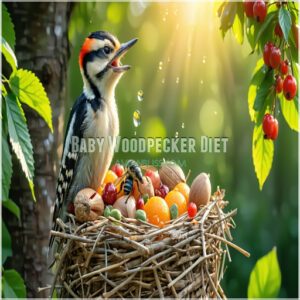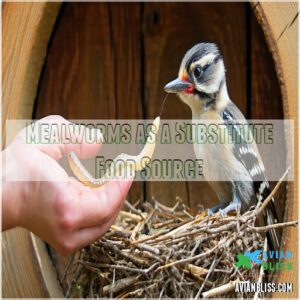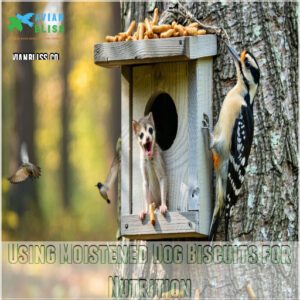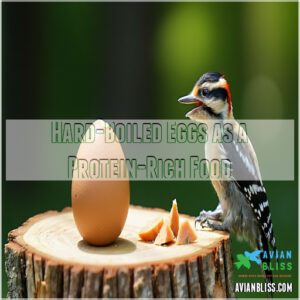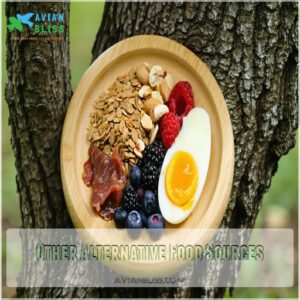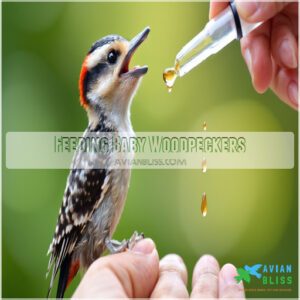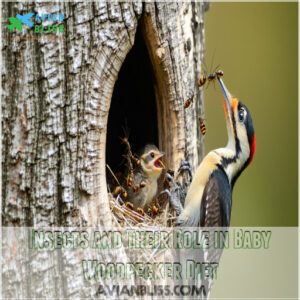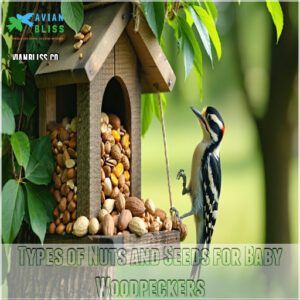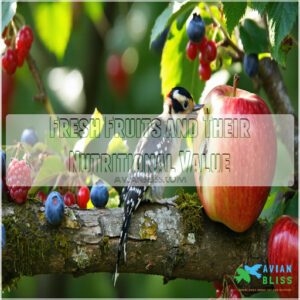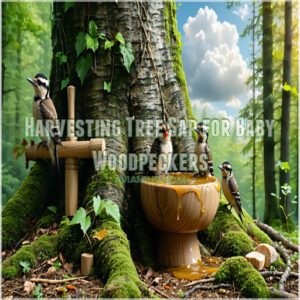This site is supported by our readers. We may earn a commission, at no cost to you, if you purchase through links.

Their meals include small insects like grubs and larvae, which are basically nature’s protein bars, along with nuts, seeds, and fruits like berries.
Tree sap is another essential, acting as their sugary energy drink loaded with minerals and amino acids.
To thrive, they need frequent, small feedings, mimicking what their parents provide in the wild.
Calcium-rich foods are a must—strong bones don’t grow themselves!
If you find an orphaned chick, mealworms, moistened dog biscuits, or mashed hard-boiled eggs can be lifesavers.
And trust me, there’s more than meets the eye about these peckish fledglings!
Table Of Contents
- Key Takeaways
- Baby Woodpecker Diet
- Foods for Baby Woodpeckers
- Feeding Baby Woodpeckers
- Natural Food Sources
- Supporting Baby Woodpeckers
- Frequently Asked Questions (FAQs)
- What do Baby woodpeckers eat?
- What do woodpeckers eat?
- Do woodpeckers eat baby birds?
- Do Baby woodpeckers eat grubs?
- Can baby woodpeckers eat dry food?
- Can you feed a baby woodpecker bread or milk?
- Is drumming related to feeding?
- Do woodpeckers eat wood?
- Do woodpeckers eat safflower seeds?
- Do woodpeckers eat baby birds or other adult birds?
- Conclusion
Key Takeaways
- Baby woodpeckers thrive on a high-protein diet, including insects like grubs and larvae, along with nuts, seeds, fruits, and even tree sap.
- Calcium-rich foods are essential for strong bones, while frequent small feedings throughout the day mimic their natural feeding habits.
- Avoid feeding them bread, milk, or dry foods unless softened, as these can harm their digestion.
- If you’re unsure about their care, consult a wildlife rehab center for expert guidance and proper nutrition tips.
Baby Woodpecker Diet
You’ll find that baby woodpeckers thrive on a protein-packed diet full of insects, nuts, seeds, fruit, and even tree sap.
Their rapid growth means they need frequent meals, so get ready to channel your inner chef if you’re caring for one, which involves providing a diet that is full of insects.
Nutritional Requirements for Growth
Think of a baby woodpecker’s diet like building blocks—miss one, and the structure wobbles.
A proper baby woodpecker diet focuses on nutrient balance to fuel those critical growth stages.
Calcium-rich foods strengthen their bones, ensuring they can conquer treetops later.
Neglect their dietary needs, and you risk deficiencies like iodine, stunting overall development.
Parenting isn’t easy, but feeding techniques centered on their exact needs mean thriving little chicks.
Understanding the baby woodpecker needs is essential for creating a well-rounded diet that supports healthy growth and development.
Importance of Protein-Rich Foods
Protein intake is the backbone of a baby woodpecker’s growth.
Without a protein-rich diet, their muscles and feathers won’t thrive.
For further information, explore this detailed baby woodpecker resource.
Key foods in a woodpecker chick diet include:
- Insects: Essential for muscle development.
- Mealworms: Easy to digest, ideal for feeding habits.
- Hard-boiled eggs: Handy protein substitute.
- Nuts: Energy-packed delights meeting dietary needs.
Balance guarantees their healthy development!
Balancing Insects, Nuts, Seeds, and Fruit
Feeding baby woodpeckers is like creating the ultimate tasting menu.
They thrive on a nutrient balance of tasty insect sources, seed selection, nuts, and fruit nutrition.
Insects fuel their early growth, while seeds and fruits turn into snacks as they mature.
A woodpecker chick diet needs this food variety to mimic what parent birds would naturally provide.
For proper care, understanding local wildlife rehab is vital to guarantee the baby woodpeckers receive a proper diet and care.
Role of Tree Sap in Their Diet
You mightn’t guess it, but tree sap is like nature’s energy drink for baby woodpeckers.
Packed with sugars, minerals, and amino acids, it fuels their rapid growth.
Woodpeckers tap trees—tiny holes, big payoff—to access this sweet treat.
When sap isn’t available, a homemade sugar-water solution can step in, keeping their energy high.
Balanced with an insect diet, it’s an unforgettable part of their woodpecker nutrition.
Foods for Baby Woodpeckers
When feeding baby woodpeckers, you’ll want to stick to foods that are soft and nutrient-packed.
They need a careful balance of protein and moisture to grow strong and healthy, from insects to moistened dog biscuits.
Mealworms as a Substitute Food Source
When your baby woodpecker needs extra nutrition, five key elements about mealworms make them an ideal food source.
- They’re packed with protein, making them perfect for growing chicks
- Their soft bodies are easy to digest and process
- They contain essential fats necessary for development
- You can raise them at home with basic insect farming setups
- They mimic woodpeckers’ natural insect diet in the wild
Just remember to squeeze the heads first to prevent escape.
Raising mealworms requires proper mealworm food management to guarantee their health and nutritional value.
Using Moistened Dog Biscuits for Nutrition
While mealworms offer great protein, moistened dog biscuits pack a surprising nutritional punch for hungry woodpecker chicks.
Here’s what makes them work:
- Soak biscuits until they’re spongy – this matches the texture they’d get from parent birds
- Pick varieties without artificial additives or preservatives
- Look for calcium-enriched options to support growing bones
- Keep portions small, offering them alongside other foods like insects
You’ll find these simple biscuits become a handy backup in your feeding routine.
When selecting biscuits, consider the benefits of moistened dog biscuits for ideal nutrition.
Hard-Boiled Eggs as a Protein-Rich Food
Hard-boiled eggs pack a powerful protein punch that’s perfect for your growing woodpecker chick.
When preparing this protein-rich diet staple, chop the egg into tiny, manageable pieces – about the size of an ant.
You’ll want to serve these nutritious bites every couple of hours, watching carefully for signs your little one’s had enough.
The complete amino acids in eggs support healthy development and feather growth.
Understanding the baby woodpecker diet is vital for providing the right nutrients for healthy growth and development.
Other Alternative Food Sources
Looking beyond hard-boiled eggs, you’ve got plenty of options for your feathered friend.
Raw liver delivers iron-packed nutrition, while moistened dog food offers protein in a soft, manageable form.
Mix in some fruit purees like mashed berries or apple sauce for vitamins, and don’t forget about softened nuts.
Just remember to keep everything spongy – these little woodpeckers need food that’s easy to handle.
Feeding Baby Woodpeckers
You’ll need to feed your baby woodpecker every 15-30 minutes from sunrise to sunset, just like their parents do in the wild.
For the best results, you can use a gentle eye-dropper for liquids and soft-tipped tweezers for solid foods, making sure to tap the beak lightly to encourage feeding.
Establishing a Feeding Schedule
Setting up meal times for your feathered friend means diving into a thoughtful nutrition timing routine.
You’ll want to monitor their growth monitoring patterns closely.
To achieve this, consider the following steps:
- Track feeding responses by keeping a simple log of when they’re most active
- Adjust food portions based on their hunger signals
- Match natural feeding intervals to their age and development
- Create a flexible schedule management system that adapts to their changing needs
Just like human babies, consistency in baby woodpecker care makes all the difference in their development.
Frequency of Feedings Throughout The Day
Caring for a baby woodpecker means keeping up with their demanding feeding schedule .
You’ll need to provide nutrition every 15-30 minutes from sunrise to sunset, just like their parents do in nature.
The feeding frequency varies by age, as outlined in the table below:
| Age Stage | Feeding Times | Daily Frequency |
|---|---|---|
| Newborn | Every 15 min | 40-50 times |
| Week 1-2 | Every 30 min | 25-30 times |
| Week 3+ | Every 45 min | 15-20 times |
This demanding feeding schedule is crucial for the baby woodpecker’s development, and it’s essential to follow it closely to ensure the bird’s health and well-being, especially during the initial newborn stage.
Replicating Natural Feeding Patterns
Feeding baby woodpeckers should mimic their natural routines—quick bursts throughout the day, just like busy parent birds.
Stick to small, protein-packed meals spread out often.
Watch for their hunger cues and adapt based on age and growth.
- Tap the beak gently to encourage eating
- Verify that food is moist and easy to digest
- Balance insects, fruit, and nuts
- Feed rhythmically for digestive health
Tips for Feeding Orphaned Baby Woodpeckers
If you’re stepping in to help a baby woodpecker, timing and proper food matter.
Stick to a strict feeding schedule—every 15-30 minutes during daylight hours.
Use softened woodpecker baby food like mealworms or moistened dog biscuits, and gently tap their beak to encourage eating.
Always avoid milk, water, or bread, as these can be harmful.
When unsure, contact a wildlife rehab center; they’re the real MVPs of bird rescue.
Natural Food Sources
You’d be amazed at how much nature provides for baby woodpeckers, from juicy insects to nutritious tree sap.
These calorie-packed foods give them the energy they need to grow into strong, lively birds.
Insects and Their Role in Baby Woodpecker Diet
You’re probably wondering, “What do baby woodpeckers eat that packs such a punch?”
Insects are the perfect answer, think ants, spiders, beetles, and juicy insect larvae—they’re nature’s protein bars.
Woodpecker parents work hard, using their sharp beaks like tiny pickaxes during wild foraging, snagging bug grubs hidden in bark or trees.
These bites fuel rapid growth like nothing else, making insects a crucial part of their diet, and juicy insect larvae are especially beneficial.
Types of Nuts and Seeds for Baby Woodpeckers
When thinking about what baby woodpeckers eat, nuts and seeds like sunflower seeds and pine nuts pack a nutritious punch.
Chop them finely, avoid salt, and balance with insects for a complete woodpecker diet.
Curious about peanut benefits? They’re loaded with protein! But don’t forget to keep these soft for baby birds.
- Try these nuts and seeds:
- Sunflower seeds (unsalted)
- Pine nuts
- Crushed walnuts
- Safflower-rich blends
Fresh Fruits and Their Nutritional Value
Berries, apples, and other fruits are like a superfood buffet for baby woodpeckers, loaded with vitamins, fiber, and hydration, they’re key to growth and energy.
Always peel, chop, and soften fruits for easy eating, providing a balanced diet that includes natural bird food supplements can be beneficial for their overall health.
Wondering what do baby woodpeckers eat, here’s a quick table of fruit nutrition:
| Fruit | Nutrient Content | Berry Benefits |
|---|---|---|
| Blueberries | Antioxidants, fiber | Boost immunity |
| Apples | Vitamin C, hydration | Easy energy source |
| Raspberries | Fiber, vitamins A, C | Aids digestion |
| Pears | Dietary fiber, carbs | Smooth digestive aid |
Harvesting Tree Sap for Baby Woodpeckers
Tree sap isn’t just tasty—it’s loaded with nutrients baby woodpeckers need for rapid growth.
Using safe Sap Collection Methods, such as tree tapping, lets you harvest this sticky treat responsibly.
Monitor sap flow regularly and stick to healthy trees.
If sap runs low, consider alternatives like sugar-water for woodpecker feeding.
Tree sap adds sweet value to the woodpecker fledgling food list.
For effective sap harvesting, understanding a Tree Sap Collector is essential for woodpecker care.
Supporting Baby Woodpeckers
You can help baby woodpeckers thrive by creating a safe, stress-free environment and ensuring they get proper care.
Whether it’s spotting early signs of illness or preparing them for life in the wild, your role is key to supporting their growth and survival.
Creating a Suitable Environment for Growth
A safe, comfy setup is a must for baby woodpeckers to grow happy and strong.
Think cozy yet secure! Whether using a tree hollow or a nest box design, make certain it’s snug, predator-proof, and near food sources.
- Safe, predator-resistant cavity or box
- Warm, weather-protected area
- Accessible feeding spots
- Little human activity nearby
- Ample space for growth monitoring and movement
Recognizing Signs of Malnutrition and Illness
Is your baby woodpecker showing signs of malnutrition or illness?
Check these quick cues:
- Feather health: Are they shiny and smooth? Poor feather growth signals trouble.
- Activity drop: If they’re unusually quiet, illness detection is key.
- Weak appearance: Watch out for droopy wings, weak immune systems, or growth delays.
Stay sharp—woodpecker chick care instructions can save their tiny lives!
Preparing Baby Woodpeckers for Release or Rehabilitation
Getting a baby woodpecker ready for the wild isn’t just about wings – it’s about confidence too.
Woodpecker release strategies start with proper rehabilitation techniques like reducing stress and providing a safe, familiar environment.
At six to eight weeks, they’re primed for release.
Monitor post-release behavior carefully to guarantee they’re adapting.
Remember, patience and consistency are key in baby woodpecker care, from avian nutrition to perfecting a wild-ready woodpecker diet.
Importance of Wildlife Rehabilitation Centers
Wildlife rehabilitation centers aren’t just for animal rescue—they’re superheroes for baby woodpeckers facing tough breaks.
These centers use expert rehabilitation techniques to gently nudge these tiny, helpless chicks back on their feet (or wings).
Wondering how they help? Here’s the scoop:
- Provide round-the-clock care, proper nutrition, and habitat setups customized to baby woodpeckers.
- Offer veterinary attention to treat injuries or illnesses, aiding species preservation.
- Teach communities about wildlife conservation and environmental protection.
- Work with authorities for bird rescue efforts and long-term population monitoring.
Understanding the baby woodpecker development stages is essential for effective rehabilitation and care.
Supporting these centers means investing in brighter futures for local ecosystems and vulnerable wildlife!
Frequently Asked Questions (FAQs)
What do Baby woodpeckers eat?
Funny how nature works—baby woodpeckers eat a diet rich in insects, nuts, seeds, fruits, and tree sap.
Think grubs, spiders, moistened dog food, or even boiled eggs.
Protein’s key, but no bread or milk!
What do woodpeckers eat?
Woodpeckers love insects, nuts, seeds, fruits, and tree sap.
In spring, they’ll dig into insects and sap, while fall favorites include nuts and berries.
Think of them as nature’s picky eaters with a varied menu!
Do woodpeckers eat baby birds?
Sometimes woodpeckers will eat baby birds, but it’s pretty rare.
They’re mostly into insects, nuts, and sap, but when protein is scarce, they might raid nests.
It’s nature’s survival game, not personal.
Do Baby woodpeckers eat grubs?
Like kids devouring candy, baby woodpeckers love grubs—those juicy insects are packed with protein they need to grow strong.
Tap gently on their beak with tweezers, and they’ll enthusiastically gobble them up in seconds!
Can baby woodpeckers eat dry food?
They can, but with a catch!
Dry food like dog kibble or seeds needs soaking to soften it first.
Make sure it’s spongy, or baby woodpeckers might choke—not exactly the snack they’d thank you for!
Can you feed a baby woodpecker bread or milk?
Feeding bread or milk to a baby woodpecker is like giving candy for dinner—not helpful and potentially harmful.
Stick to protein-rich, insect-based foods to nurture their growth; insect-based foods are essential for their development.
Bread and milk can cause serious digestive issues.
Is drumming related to feeding?
Drumming isn’t related to feeding; it’s how woodpeckers mark territory and attract mates.
Think of it like their version of a drum solo—loud, attention-grabbing, and all about making their presence known!
Do woodpeckers eat wood?
Imagine biting into bark like it’s a wrapper—sounds odd, right?
Woodpeckers don’t actually eat wood.
They peck for hidden insects, sap, and tasty surprises inside trees, leaving the wood bits behind.
Do woodpeckers eat safflower seeds?
Woodpeckers generally don’t prefer safflower seeds.
If you’ve got some in a feeder, they’ll probably ignore it.
They’re more into insects, nuts, or fruits—basically, snacks packed with energy, not bland birdseed!
Do woodpeckers eat baby birds or other adult birds?
About 1% of their diet includes other birds, mostly eggs or nestlings, not adults.
It’s rare but happens when food is scarce, think of it as survival instinct kicking in, not typical behavior.
Conclusion
Caring for baby woodpeckers is like nurturing a delicate flame—it needs the right fuel to thrive.
Their diet, packed with protein from insects, nuts, seeds, and fruits, mirrors nature’s balance.
Understanding what baby woodpeckers eat means mimicking their wild feedings with mealworms or moistened dog biscuits.
By meeting their nutritional needs and feeding them frequently, you’re setting them up for healthy growth.
And remember, wildlife rehab centers can be invaluable if you’re ever unsure, providing the necessary care with the right nutritional needs.
- https://www.justanswer.com/bird-vet/3ujgk-feed-care-baby-woodpecker-i-found.html
- https://thesquirrelboard.com/forums/archive/index.php/t-28718.html
- https://www.reddit.com/r/WildlifeRehab/comments/15q6qun/orphaned_baby_bird_what_do_i_feed_him_and_how/
- https://www.massaudubon.org/nature-wildlife/birds/woodpeckers
- https://www.allaboutbirds.org/guide/browse/shape/Woodpeckers

